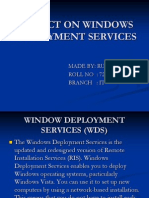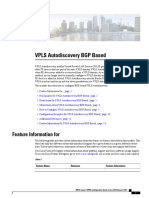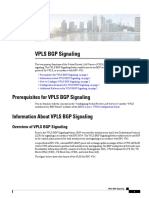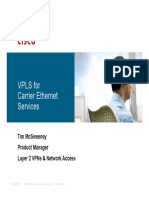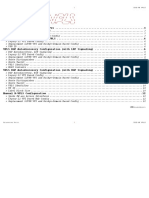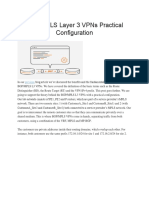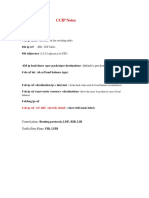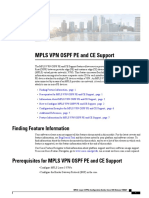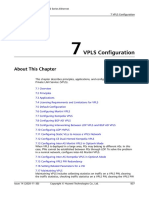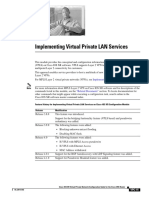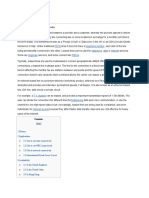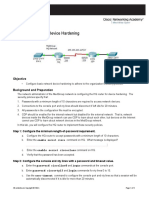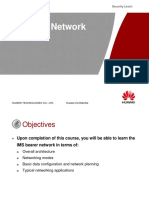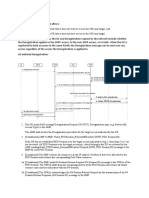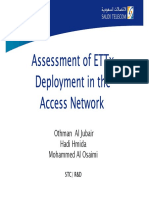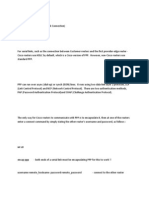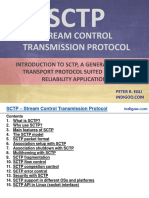Vpls Auto BGP Xe
Uploaded by
milosVpls Auto BGP Xe
Uploaded by
milosVPLS Autodiscovery BGP Based
VPLS Autodiscovery enables Virtual Private LAN Service (VPLS) provider edge (PE) devices to discover
other PE devices that are part of the same VPLS ___domain. VPLS Autodiscovery also automatically detects
when PE devices are added to or removed from a VPLS ___domain. As a result, with VPLS Autodiscovery
enabled, you no longer need to manually configure a VPLS ___domain and maintain the configuration when a
PE device is added or deleted. VPLS Autodiscovery uses the Border Gateway Protocol (BGP) to discover
VPLS members and set up and tear down pseudowires in a VPLS ___domain.
This module describes how to configure BGP-based VPLS Autodiscovery.
Finding Feature Information, page 1
Restrictions for VPLS Autodiscovery BGP Based, page 1
Information About VPLS Autodiscovery BGP Based, page 2
How to Configure VPLS Autodiscovery BGP Based, page 6
Configuration Examples for VPLS Autodiscovery BGP Based, page 23
Additional References for VPLS Autodiscovery BGP Based, page 30
Feature Information for VPLS Autodiscovery BGP Based, page 31
Finding Feature Information
Your software release may not support all the features documented in this module. For the latest caveats and
feature information, see Bug Search Tool and the release notes for your platform and software release. To
find information about the features documented in this module, and to see a list of the releases in which each
feature is supported, see the feature information table at the end of this module.
Use Cisco Feature Navigator to find information about platform support and Cisco software image support.
To access Cisco Feature Navigator, go to www.cisco.com/go/cfn. An account on Cisco.com is not required.
Restrictions for VPLS Autodiscovery BGP Based
Virtual Private LAN Service (VPLS) Autodiscovery supports only IPv4 addresses.
MPLS Layer 2 VPNs Configuration Guide, Cisco IOS XE Release 3S (ASR 1000)
1
VPLS Autodiscovery BGP Based
Information About VPLS Autodiscovery BGP Based
VPLS Autodiscovery uses Forwarding Equivalence Class (FEC) 129 to convey endpoint information.
Manually configured pseudowires use FEC 128.
VPLS Autodiscovery is not supported with Layer 2 Tunnel Protocol Version 3 (L2TPv3).
You can configure both autodiscovered and manually configured pseudowires in a single virtual
forwarding instance (VFI). However, you cannot configure different pseudowires on the same peer PE
device.
After enabling VPLS Autodiscovery, if you manually configure a neighbor by using the neighbor
command and both peers are in autodiscovery mode, each peer will receive discovery data for that VPLS.
To prevent peers from receiving data for the VPLS ___domain, manually configure route target (RT) values.
If you manually configure multiple pseudowires and target different IP addresses on the same PE device
for each pseudowire, do not use the same virtual circuit (VC) ID to identify pseudowires that terminate
at the same PE device.
If you manually configure a neighbor on one PE device, you cannot configure the same pseudowire in
the other direction by using autodiscovery on another PE device.
Tunnel selection is not supported with autodiscovered neighbors.
Up to 16 RTs are supported per VFI.
The same RT is not allowed in multiple VFIs on the same PE device.
The Border Gateway Protocol (BGP) autodiscovery process does not support dynamic, hierarchical
VPLS. User-facing PE (U-PE) devices cannot discover network-facing PE (N-PE) devices, and N-PE
devices cannot discover U-PE devices.
Pseudowires for autodiscovered neighbors have split horizon enabled. (A split horizon is enabled by
default on all interfaces. A split horizon blocks route information from being advertised by a device,
irrespective of the interface from which the information originates.) Therefore, manually configure
pseudowires for hierarchical VPLS. Ensure that U-PE devices do not participate in BGP autodiscovery
for these pseudowires.
Do not disable split horizon on autodiscovered neighbors. Split horizon is required with VPLS
Autodiscovery.
The provisioned peer address must be a /32 address bound to the peers Label Distribution Protocol
(LDP) router ID.
A peer PE device must be able to access the IP address that is used as the local LDP router ID. Even if
the IP address is not used in the xconnect command on the peer PE device, the IP address must be
reachable.
Information About VPLS Autodiscovery BGP Based
How VPLS Works
Virtual Private LAN Service (VPLS) allows Multiprotocol Label Switching (MPLS) networks to provide
multipoint Ethernet LAN services, also known as Transparent LAN Services (TLS). All customer sites in a
VPLS appear to be on the same LAN, even though these sites might be in different geographic locations.
MPLS Layer 2 VPNs Configuration Guide, Cisco IOS XE Release 3S (ASR 1000)
2
VPLS Autodiscovery BGP Based
How the VPLS Autodiscovery BGP Based Feature Works
How the VPLS Autodiscovery BGP Based Feature Works
VPLS Autodiscovery enables each Virtual Private LAN Service (VPLS) provider edge (PE) device to discover
other PE devices that are part of the same VPLS ___domain. VPLS Autodiscovery also tracks PE devices when
they are added to or removed from a VPLS ___domain. Autodiscovery and signaling functions use the Border
Gateway Protocol (BGP) to find and track PE devices.
BGP uses the Layer 2 VPN (L2VPN) Routing Information Base (RIB) to store endpoint provisioning
information, which is updated each time any Layer 2 virtual forwarding instance (VFI) is configured. The
prefix and path information is stored in the L2VPN database, which allows BGP to make decisions about the
best path. When BGP distributes the endpoint provisioning information in an update message to all its BGP
neighbors, this endpoint information is used to configure a pseudowire mesh to support L2VPN-based services.
The BGP autodiscovery mechanism facilitates the configuration of L2VPN services, which are an integral
part of the VPLS feature. VPLS enables flexibility in deploying services by connecting geographically dispersed
sites as a large LAN over high-speed Ethernet in a robust and scalable IP Multiprotocol Label Switching
(MPLS) network. For more information about BGP and the L2VPN address family in relation to VPLS
Autodiscovery, see the following chapters in the IP Routing: BGP Configuration Guide:
L2VPN Address Family section in the Cisco BGP Overview chapter
BGP Support for the L2VPN Address Family chapter
How Enabling VPLS Autodiscovery Differs from Manually Configuring VPLS
With VPLS Autodiscovery enabled, you no longer need to manually set up Virtual Private LAN Service
(VPLS). The commands that you use to set up VPLS Autodiscovery are similar to those that you use to
manually configure VPLS, as shown in the table below. VPLS Autodiscovery uses neighbor commands in
L2VPN address family mode to distribute endpoint information to configure a pseudowire.
Table 1: Manual VPLS Configuration Versus VPLS Autodiscovery Configuration
Manual Configuration of VPLS
VPLS Autodiscovery BGP Based
l2 vfi vpls1 manual
vpn id 100
neighbor 10.10.10.1 encapsulation mpls
neighbor 10.10.10.0 encapsulation mpls
exit
l2 vfi vpls1 autodiscovery
vpn id 100
exit
router bgp 1
no bgp default ipv4-unicast
bgp log-neighbor-changes
bgp update-delay 1
neighbor 10.1.1.2 remote-as 1
neighbor 10.1.1.2 update-source Loopback1
.
.
.
address-family l2vpn vpls
neighbor 10.1.1.2 activate
neighbor 10.1.1.2 send-community extended
exit-address-family
Configure VPLS Autodiscovery by using the l2 vfi autodiscovery command. This command allows a virtual
forwarding instance (VFI) to learn and advertise pseudowire endpoints. As a result, you no longer need to
enter the neighbor command in L2 VFI configuration mode.
MPLS Layer 2 VPNs Configuration Guide, Cisco IOS XE Release 3S (ASR 1000)
3
VPLS Autodiscovery BGP Based
How Enabling VPLS Autodiscovery Differs from Manually Configuring VPLS using the commands associated with
the L2VPN Protocol-Based CLIs feature
However, the neighbor command is still supported with VPLS Autodiscovery in L2 VFI configuration mode.
You can use the neighbor command to allow PE devices that do not participate in the autodiscovery process
to join the VPLS ___domain. You can also use the neighbor command with PE devices that have been configured
using the Tunnel Selection feature. In addition, you can use the neighbor command in hierarchical VPLS
configurations that have user-facing PE (U-PE) devices that do not participate in the autodiscovery process
and have split-horizon forwarding disabled.
How Enabling VPLS Autodiscovery Differs from Manually Configuring VPLS
using the commands associated with the L2VPN Protocol-Based CLIs feature
With VPLS Autodiscovery enabled, you no longer need to manually set up Virtual Private LAN Service
(VPLS). The commands that you use to set up VPLS Autodiscovery are similar to those that you use to
manually configure VPLS, as shown in the table below. VPLS Autodiscovery uses neighbor commands in
L2VPN address family mode to distribute endpoint information to configure a pseudowire.
Table 2: Manual VPLS Configuration Versus VPLS Autodiscovery Configuration
Manual Configuration of VPLS
VPLS Autodiscovery BGP Based
l2vpn vfi context vpls1
vpn id 100
neighbor 10.10.10.1 encapsulation mpls
neighbor 10.10.10.0 encapsulation mpls
exit
l2vpn vfi context vpls1
vpn id 100
autodiscovery bgp signaling ldp
exit
router bgp 1
no bgp default ipv4-unicast
bgp log-neighbor-changes
bgp update-delay 1
neighbor 10.1.1.2 remote-as 1
neighbor 10.1.1.2 update-source Loopback1
.
.
.
address-family l2vpn vpls
neighbor 10.1.1.2 activate
neighbor 10.1.1.2 send-community extended
exit-address-family
Configure VPLS Autodiscovery by using the autodiscovery command. This command allows a virtual
forwarding instance (VFI) to learn and advertise pseudowire endpoints. As a result, you no longer need to
enter the neighbor command in L2 VFI configuration mode.
However, the neighbor command is still supported with VPLS Autodiscovery in L2 VFI configuration mode.
You can use the neighbor command to allow PE devices that do not participate in the autodiscovery process
to join the VPLS ___domain. You can also use the neighbor command with PE devices that have been configured
using the Tunnel Selection feature. In addition, you can use the neighbor command in hierarchical VPLS
configurations that have user-facing PE (U-PE) devices that do not participate in the autodiscovery process
and have split-horizon forwarding disabled.
show Commands Affected by VPLS Autodiscovery BGP Based
The following show commands were enhanced for VPLS Autodiscovery:
MPLS Layer 2 VPNs Configuration Guide, Cisco IOS XE Release 3S (ASR 1000)
4
VPLS Autodiscovery BGP Based
BGP VPLS Autodiscovery Support on a Route Reflector
The show mpls l2transport vc detail command was updated to include Forwarding Equivalence Class
(FEC) 129 signaling information for autodiscovered Virtual Private LAN Service (VPLS) pseudowires.
The show vfi command was enhanced to display information related to autodiscovered virtual forwarding
instances (VFIs). The new output includes the VPLS ID, the route distinguisher (RD), the route target
(RT), and router IDs of discovered peers.
The show xconnect command was updated with the rib keyword to provide Routing Information Base
(RIB) information about pseudowires.
BGP VPLS Autodiscovery Support on a Route Reflector
By default, routes received from an internal BGP (iBGP) peer are not sent to another iBGP peer unless a full
mesh configuration is formed between all BGP devices within an autonomous system (AS). This results in
scalability issues. Using Border Gateway Protocol (BGP) route reflectors leads to much higher levels of
scalability. Configuring a route reflector allows a device to advertise or reflect the iBGP learned routes to
other iBGP speakers.
Virtual Private LAN Service (VPLS) Autodiscovery supports BGP route reflectors. A BGP route reflector
can be used to reflect BGP VPLS prefixes without VPLS being explicitly configured on the route reflector.
A route reflector does not participate in autodiscovery; that is, no pseudowires are set up between the route
reflector and the PE devices. A route reflector reflects VPLS prefixes to other PE devices so that these PE
devices do not need to have a full mesh of BGP sessions. The network administrator configures only the BGP
VPLS address family on a route reflector. For an example configuration of VPLS Autodiscovery support on
a route reflector, see the Example: BGP VPLS Autodiscovery Support on Route Reflector section.
N-PE Access to VPLS Using MST
When a Virtual Private LAN Service (VPLS) network uses multihoming (network-facing PE [N-PE] VPLS
redundancy) to prevent a single point of failure of an N-PE device, a bridging loop is introduced. One of the
N-PE devices can be set as a Multiple Spanning Tree (MST) root to break the loop. In most cases, the two
N-PE devices are also separated by a distance that makes direct physical link impossible. You can configure
a virtual link (usually through the same VPLS core network) between the two N-PE devices to pass an MST
bridge protocol data unit (BPDU) for path calculation, break the loop, and maintain convergence. The virtual
link is created using a special pseudowire between the active and redundant N-PE devices.
While setting up an MST topology for a VPLS PE device, ensure the following:
The spanning-tree mode mst command is enabled on all PE devices (N-PE and user-facing PE [U-PE])
participating in the MST topology.
A special pseudowire is configured between the two N-PE devices, and these two devices are in the up
state.
The special pseudowire is a manually created virtual forwarding instance (VFI).
The configuration (inlcuding the MST instance, the Ethernet virtual circuit [EVC], and the VLAN) on
all PE devices is the same.
One of the N-PE devices, and not one of the U-PE devices, is the root for the MST instance.
The name and revision for the MST configuration are configured to synchronize with the standby Route
Processor (RP).
MPLS Layer 2 VPNs Configuration Guide, Cisco IOS XE Release 3S (ASR 1000)
5
VPLS Autodiscovery BGP Based
How to Configure VPLS Autodiscovery BGP Based
How to Configure VPLS Autodiscovery BGP Based
Enabling VPLS Autodiscovery BGP Based
Perform this task to enable Virtual Private LAN Service (VPLS) PE devices to discover other PE devices that
are part of the same VPLS ___domain.
SUMMARY STEPS
1. enable
2. configure terminal
3. l2 vfi vfi-name autodiscovery
4. vpn id vpn-id
5. end
DETAILED STEPS
Step 1
Command or Action
Purpose
enable
Enables privileged EXEC mode.
Example:
Enter your password if prompted.
Device> enable
Step 2
configure terminal
Enters global configuration mode.
Example:
Device# configure terminal
Step 3
l2 vfi vfi-name autodiscovery
Enables VPLS Autodiscovery on a PE device and enters L2
VFI configuration mode.
Example:
Device(config)# l2 vfi vpls1 autodiscovery
Step 4
vpn id vpn-id
Configures a VPN ID for the VPLS ___domain.
Example:
Device(config-vfi)# vpn id 10
Step 5
end
Example:
Device(config-vfi)# end
Exits L2 VFI configuration mode and returns to privileged
EXEC mode.
Commands take effect after the device exits L2 VFI
configuration mode.
MPLS Layer 2 VPNs Configuration Guide, Cisco IOS XE Release 3S (ASR 1000)
6
VPLS Autodiscovery BGP Based
Enabling VPLS Autodiscovery BGP Based using the commands associated with the L2VPN Protocol-Based CLIs
feature
Enabling VPLS Autodiscovery BGP Based using the commands associated
with the L2VPN Protocol-Based CLIs feature
Perform this task to enable Virtual Private LAN Service (VPLS) PE devices to discover other PE devices that
are part of the same VPLS ___domain.
Before You Begin
Before configuring VPLS Autodiscovery, perform the Cisco 7600 router-specific tasks listed in the Virtual
Private LAN Services on the Optical Services Modules chapter in the Cisco 7600 Series Router Cisco IOS
Software Configuration Guide, Release 12.2SR.
SUMMARY STEPS
1. enable
2. configure terminal
3. l2vpn vfi context vfi-name
4. vpn id vpn-id
5. autodiscovery bgp signaling ldp
6. end
DETAILED STEPS
Step 1
Command or Action
Purpose
enable
Enables privileged EXEC mode.
Enter your password if prompted.
Example:
Device> enable
Step 2
Enters global configuration mode.
configure terminal
Example:
Device# configure terminal
Step 3
l2vpn vfi context vfi-name
Establishes an L2VPN VFI context and enters L2 VFI
configuration mode.
Example:
Device(config)# l2vpn vfi context vpls1
Step 4
vpn id vpn-id
Configures a VPN ID for the VPLS ___domain.
Example:
Device(config-vfi)# vpn id 10
MPLS Layer 2 VPNs Configuration Guide, Cisco IOS XE Release 3S (ASR 1000)
7
VPLS Autodiscovery BGP Based
Configuring BGP to Enable VPLS Autodiscovery
Step 5
Command or Action
Purpose
autodiscovery bgp signaling ldp
Enables the VPLS Autodiscovery: BGP Based feature on the
PE device.
Example:
Device(config-vfi)# autodiscovery bgp
signaling ldp
Step 6
Exits L2 VFI configuration mode and returns to privileged
EXEC mode.
end
Example:
Device(config-vfi)# end
Commands take effect after the device exits L2 VFI
configuration mode.
Configuring BGP to Enable VPLS Autodiscovery
The Border Gateway Protocol (BGP) Layer 2 VPN (L2VPN) address family supports a separate L2VPN
Routing Information Base (RIB) that contains endpoint provisioning information for Virtual Private LAN
Service (VPLS) Autodiscovery. BGP learns the endpoint provisioning information from the L2VPN database,
which is updated each time a Layer 2 virtual forwarding instance (VFI) is configured. When BGP distributes
the endpoint provisioning information in an update message to all its BGP neighbors, the endpoint information
is used to configure a pseudowire mesh to support L2VPN-based services.
SUMMARY STEPS
1. enable
2. configure terminal
3. router bgp autonomous-system-number
4. no bgp default ipv4-unicast
5. bgp log-neighbor-changes
6. neighbor {ip-address | peer-group-name} remote-as autonomous-system-number
7. neighbor {ip-address | peer-group-name} update-source interface-type interface-number
8. Repeat Steps 6 and 7 to configure other BGP neighbors.
9. address-family l2vpn [vpls]
10. neighbor {ip-address | peer-group-name} activate
11. neighbor {ip-address | peer-group-name} send-community {both | standard | extended}
12. Repeat Steps 10 and 11 to activate other BGP neighbors under an L2VPN address family.
13. exit-address-family
14. end
15. show vfi
16. show ip bgp l2vpn vpls {all | rd route-distinguisher}
MPLS Layer 2 VPNs Configuration Guide, Cisco IOS XE Release 3S (ASR 1000)
8
VPLS Autodiscovery BGP Based
Configuring BGP to Enable VPLS Autodiscovery
DETAILED STEPS
Step 1
Command or Action
Purpose
enable
Enables privileged EXEC mode.
Enter your password if prompted.
Example:
Device> enable
Step 2
Enters global configuration mode.
configure terminal
Example:
Device# configure terminal
Step 3
router bgp autonomous-system-number
Enters router configuration mode for the specified routing process.
Example:
Device(config)# router bgp 65000
Step 4
no bgp default ipv4-unicast
Disables the IPv4 unicast address family for the BGP routing
process.
Example:
Note
Device(config-router)# no bgp default
ipv4-unicast
Step 5
Routing information for the IPv4 unicast address family
is advertised by default for each BGP routing session
configured using the neighbor remote-as router
configuration command unless you configure the no bgp
default ipv4-unicast router configuration command
before configuring the neighbor remote-as command.
Existing neighbor configurations are not affected.
Enables logging of BGP neighbor resets.
bgp log-neighbor-changes
Example:
Device(config-router)# bgp
log-neighbor-changes
Step 6
neighbor {ip-address | peer-group-name}
remote-as autonomous-system-number
Example:
Device(config-router)# neighbor 10.10.10.1
remote-as 65000
Adds the IP address or peer group name of the neighbor in the
specified autonomous system to the IPv4 multiprotocol BGP
neighbor table of the local device.
If the autonomous-system-number argument matches the
autonomous system number specified in the router bgp
command, the neighbor is an internal neighbor.
If the autonomous-system-number argument does not match
the autonomous system number specified in the router bgp
command, the neighbor is an external neighbor.
In this example, the neighbor at 10.10.10.1 is an internal
BGP neighbor.
Step 7
neighbor {ip-address | peer-group-name}
update-source interface-type interface-number
(Optional) Configures a device to select a specific source or
interface to receive routing table updates.
MPLS Layer 2 VPNs Configuration Guide, Cisco IOS XE Release 3S (ASR 1000)
9
VPLS Autodiscovery BGP Based
Configuring BGP to Enable VPLS Autodiscovery
Command or Action
Purpose
This example uses a loopback interface. The advantage of
this configuration is that the loopback interface is not affected
by the effects of a flapping interface.
Example:
Device(config-router)# neighbor 10.10.10.1
update-source loopback1
Step 8
Repeat Steps 6 and 7 to configure other BGP
neighbors.
Step 9
address-family l2vpn [vpls]
Specifies the L2VPN address family and enters address family
configuration mode.
Example:
The optional vpls keyword specifies that the VPLS endpoint
provisioning information is to be distributed to BGP peers.
Device(config-router)# address-family l2vpn
vpls
In this example, an L2VPN VPLS address family session is
created.
Step 10
neighbor {ip-address | peer-group-name} activate Enables the exchange of information with a BGP neighbor.
Example:
Device(config-router-af)# neighbor
10.10.10.1 activate
Step 11
neighbor {ip-address | peer-group-name}
send-community {both | standard | extended}
Specifies that a communities attribute should be sent to a BGP
neighbor.
In this example, an extended communities attribute is sent
to the neighbor at 10.10.10.1.
Example:
Device(config-router-af)# neighbor
10.10.10.1 send-community extended
Step 12
Repeat Steps 10 and 11 to activate other BGP
neighbors under an L2VPN address family.
Step 13
exit-address-family
Exits address family configuration mode and returns to router
configuration mode.
Example:
Device(config-router-af)#
exit-address-family
Step 14
end
Exits router configuration mode and returns to privileged EXEC
mode.
Example:
Device(config-router)# end
Step 15
show vfi
Displays information about the configured VFI instances.
Example:
Device# show vfi
Step 16
show ip bgp l2vpn vpls {all | rd
route-distinguisher}
Displays information about the L2VPN VPLS address family.
MPLS Layer 2 VPNs Configuration Guide, Cisco IOS XE Release 3S (ASR 1000)
10
VPLS Autodiscovery BGP Based
Configuring BGP to Enable VPLS Autodiscovery using the commands associated with the L2VPN Protocol-Based
CLIs feature
Command or Action
Purpose
Example:
Device# show ip bgp l2vpn vpls all
Configuring BGP to Enable VPLS Autodiscovery using the commands associated
with the L2VPN Protocol-Based CLIs feature
The BGP L2VPN address family supports a separate L2VPN Routing Information Base (RIB) that contains
endpoint provisioning information for Virtual Private LAN Service (VPLS) Autodiscovery. BGP learns the
endpoint provisioning information from the L2VPN database, which is updated each time a Layer 2 virtual
forwarding instance (VFI) is configured. When BGP distributes the endpoint provisioning information in an
update message to all its BGP neighbors, the endpoint information is used to configure a pseudowire mesh
to support L2VPN-based services.
SUMMARY STEPS
1. enable
2. configure terminal
3. router bgp autonomous-system-number
4. no bgp default ipv4-unicast
5. bgp log-neighbor-changes
6. neighbor {ip-address | peer-group-name} remote-as autonomous-system-number
7. neighbor {ip-address | peer-group-name} update-source interface-type interface-number
8. Repeat Steps 6 and 7 to configure other BGP neighbors.
9. address-family l2vpn [vpls]
10. neighbor {ip-address | peer-group-name} activate
11. neighbor {ip-address | peer-group-name} send-community {both | standard | extended}
12. Repeat Steps 10 and 11 to activate other BGP neighbors under an L2VPN address family.
13. exit-address-family
14. end
15. show l2vpn vfi
16. show ip bgp l2vpn vpls {all | rd route-distinguisher}
DETAILED STEPS
Step 1
Command or Action
Purpose
enable
Enables privileged EXEC mode.
MPLS Layer 2 VPNs Configuration Guide, Cisco IOS XE Release 3S (ASR 1000)
11
VPLS Autodiscovery BGP Based
Configuring BGP to Enable VPLS Autodiscovery using the commands associated with the L2VPN Protocol-Based
CLIs feature
Command or Action
Purpose
Enter your password if prompted.
Example:
Device> enable
Step 2
configure terminal
Enters global configuration mode.
Example:
Device# configure terminal
Step 3
router bgp autonomous-system-number
Enters router configuration mode for the specified routing process.
Example:
Device(config)# router bgp 65000
Step 4
no bgp default ipv4-unicast
Disables the IPv4 unicast address family for the BGP routing
process.
Example:
Note
Device(config-router)# no bgp default
ipv4-unicast
Step 5
bgp log-neighbor-changes
Routing information for the IPv4 unicast address family
is advertised by default for each BGP routing session
configured using the neighbor remote-as router
configuration command unless you configure the no bgp
default ipv4-unicast router configuration command
before configuring the neighbor remote-as command.
Existing neighbor configurations are not affected.
Enables logging of BGP neighbor resets.
Example:
Device(config-router)# bgp
log-neighbor-changes
Step 6
neighbor {ip-address | peer-group-name}
remote-as autonomous-system-number
Example:
Device(config-router)# neighbor 10.10.10.1
remote-as 65000
Adds the IP address or peer group name of the neighbor in the
specified autonomous system to the IPv4 multiprotocol BGP
neighbor table of the local device.
If the autonomous-system-number argument matches the
autonomous system number specified in the router bgp
command, the neighbor is an internal neighbor.
If the autonomous-system-number argument does not match
the autonomous system number specified in the router bgp
command, the neighbor is an external neighbor.
In this example, the neighbor at 10.10.10.1 is an internal BGP
neighbor.
Step 7
neighbor {ip-address | peer-group-name}
update-source interface-type interface-number
(Optional) Configures a device to select a specific source or
interface to receive routing table updates.
MPLS Layer 2 VPNs Configuration Guide, Cisco IOS XE Release 3S (ASR 1000)
12
VPLS Autodiscovery BGP Based
Configuring BGP to Enable VPLS Autodiscovery using the commands associated with the L2VPN Protocol-Based
CLIs feature
Command or Action
Purpose
This example uses a loopback interface. The advantage of
this configuration is that the loopback interface is not affected
by the effects of a flapping interface.
Example:
Device(config-router)# neighbor 10.10.10.1
update-source loopback1
Step 8
Repeat Steps 6 and 7 to configure other BGP
neighbors.
Step 9
address-family l2vpn [vpls]
Specifies the L2VPN address family and enters address family
configuration mode.
Example:
The optional vpls keyword specifies that the VPLS endpoint
provisioning information is to be distributed to BGP peers.
Device(config-router)# address-family l2vpn
vpls
In this example, an L2VPN VPLS address family session is
created.
Step 10
neighbor {ip-address | peer-group-name} activate Enables the exchange of information with a BGP neighbor.
Example:
Device(config-router-af)# neighbor
10.10.10.1 activate
Step 11
neighbor {ip-address | peer-group-name}
send-community {both | standard | extended}
Specifies that a communities attribute should be sent to a BGP
neighbor.
In this example, an extended communities attribute is sent
to the neighbor at 10.10.10.1.
Example:
Device(config-router-af)# neighbor
10.10.10.1 send-community extended
Step 12
Repeat Steps 10 and 11 to activate other BGP
neighbors under an L2VPN address family.
Step 13
exit-address-family
Exits address family configuration mode and returns to router
configuration mode.
Example:
Device(config-router-af)#
exit-address-family
Step 14
end
Exits router configuration mode and returns to privileged EXEC
mode.
Example:
Device(config-router)# end
Step 15
show l2vpn vfi
Displays information about the Layer 2 VPN (L2VPN) virtual
forwarding instances (VFI).
Example:
Device# show l2vpn vfi
MPLS Layer 2 VPNs Configuration Guide, Cisco IOS XE Release 3S (ASR 1000)
13
VPLS Autodiscovery BGP Based
Customizing the VPLS Autodiscovery Settings
Step 16
Command or Action
Purpose
show ip bgp l2vpn vpls {all | rd
route-distinguisher}
Displays information about the L2VPN VPLS address family.
Example:
Device# show ip bgp l2vpn vpls all
Customizing the VPLS Autodiscovery Settings
Several commands allow you to customize the Virtual Private LAN Service (VPLS) environment. You can
specify identifiers for the VPLS ___domain, the route distinguisher (RD), the route target (RT), and the provider
edge (PE) device. Perform this task to customize these identifiers.
SUMMARY STEPS
1. enable
2. configure terminal
3. l2 vfi vfi-name autodiscovery
4. vpn id vpn-id
5. vpls-id {autonomous-system-number:nn | ip-address:nn}
6. rd {autonomous-system-number:nn | ip-address:nn}
7. route-target [import | export | both] {autonomous-system-number:nn | ip-address:nn}
8. auto-route-target
9. end
DETAILED STEPS
Step 1
Command or Action
Purpose
enable
Enables privileged EXEC mode.
Example:
Enter your password if prompted.
Device> enable
Step 2
configure terminal
Enters global configuration mode.
Example:
Device# configure terminal
MPLS Layer 2 VPNs Configuration Guide, Cisco IOS XE Release 3S (ASR 1000)
14
VPLS Autodiscovery BGP Based
Customizing the VPLS Autodiscovery Settings
Step 3
Command or Action
Purpose
l2 vfi vfi-name autodiscovery
Enables VPLS Autodiscovery on the PE device and enters Layer 2 VFI
configuration mode.
Example:
Device(config)# l2 vfi vpls1
autodiscovery
Step 4
vpn id vpn-id
Configures a VPN ID for the VPLS ___domain.
Example:
Device(config-vfi)# vpn id 10
Step 5
vpls-id {autonomous-system-number:nn (Optional) Assigns an identifier to the VPLS ___domain.
| ip-address:nn}
This command is optional because VPLS Autodiscovery automatically
generates a VPLS ID using the Border Gateway Protocol (BGP)
Example:
autonomous system (AS) number and the configured VFI VPN ID. You
Device(config-vfi)# vpls-id 5:300
can use this command to change the automatically generated VPLS ID.
There are two formats for configuring the VPLS ID argument. It can
be configured in the autonomous-system-number:network number
(ASN:nn) format, as shown in the example, or it can be configured in
the IP-address:network number format (IP-address:nn).
Step 6
rd {autonomous-system-number:nn |
ip-address:nn}
Example:
Device(config-vfi)# rd 2:3
(Optional) Specifies the RD to distribute endpoint information.
This command is optional because VPLS Autodiscovery automatically
generates an RD using the BGP autonomous system number and the
configured VFI VPN ID. You can use this command to change the
automatically generated RD.
There are two formats for configuring the route distinguisher argument.
It can be configured in the autonomous-system-number:network number
(ASN:nn) format, as shown in the example, or it can be configured in
the IP-address:network number format (IP-address:nn).
Step 7
route-target [import | export | both]
{autonomous-system-number:nn |
ip-address:nn}
Example:
Device(config-vfi)# route-target
600:2222
Step 8
auto-route-target
(Optional) Specifies the RT.
This command is optional because VPLS Autodiscovery automatically
generates an RT using the lower 6 bytes of the RD and the VPLS ID.
You can use this command to change the automatically generated RT.
There are two formats for configuring the route target argument. It can
be configured in the autonomous-system-number:network number
(ASN:nn) format, as shown in the example, or it can be configured in
the IP-address:network number format (IP-address:nn).
(Optional) Enables the automatic generation of a RT.
Example:
Device(config-vfi)#
auto-route-target
MPLS Layer 2 VPNs Configuration Guide, Cisco IOS XE Release 3S (ASR 1000)
15
VPLS Autodiscovery BGP Based
Customizing the VPLS Autodiscovery Settings using the commands associated with the L2VPN Protocol-Based CLIs
feature
Step 9
Command or Action
Purpose
end
Exits L2 VFI configuration mode and returns to privileged EXEC mode.
Example:
Device(config-vfi)# end
Commands take effect after the device exits Layer 2 VFI configuration
mode.
Customizing the VPLS Autodiscovery Settings using the commands associated
with the L2VPN Protocol-Based CLIs feature
Several commands allow you to customize the Virtual Private LAN Service (VPLS) environment. You can
specify identifiers for the VPLS ___domain, the route distinguisher (RD), the route target (RT), and the provider
edge (PE) device. Perform this task to customize these identifiers.
SUMMARY STEPS
1. enable
2. configure terminal
3. l2vpn vfi context vfi-name
4. vpn id vpn-id
5. autodiscovery bgp signaling ldp
6. vpls-id {autonomous-system-number:nn | ip-address:nn}
7. rd {autonomous-system-number:nn | ip-address:nn}
8. route-target [import | export | both] {autonomous-system-number:nn | ip-address:nn}
9. auto-route-target
10. end
DETAILED STEPS
Step 1
Command or Action
Purpose
enable
Enables privileged EXEC mode.
Example:
Enter your password if prompted.
Device> enable
Step 2
configure terminal
Enters global configuration mode.
Example:
Device# configure terminal
Step 3
l2vpn vfi context vfi-name
Establishes a L2VPN VFI context and enters L2 VFI configuration mode.
MPLS Layer 2 VPNs Configuration Guide, Cisco IOS XE Release 3S (ASR 1000)
16
VPLS Autodiscovery BGP Based
Customizing the VPLS Autodiscovery Settings using the commands associated with the L2VPN Protocol-Based CLIs
feature
Command or Action
Purpose
Example:
Device(config)# l2vpn vfi context
vpls1
Step 4
vpn id vpn-id
Configures a VPN ID for the VPLS ___domain.
Example:
Device(config-vfi)# vpn id 10
Step 5
autodiscovery bgp signaling ldp
Enables the VPLS Autodiscovery: BGP Based feature on the PE device.
Example:
Device(config-vfi)# autodiscovery
bgp signaling ldp
Step 6
vpls-id {autonomous-system-number:nn | (Optional) Assigns an identifier to the VPLS ___domain.
ip-address:nn}
This command is optional because VPLS Autodiscovery automatically
generates a VPLS ID using the Border Gateway Protocol (BGP)
Example:
autonomous system (AS) number and the configured VFI VPN ID.
You can use this command to change the automatically generated
Device(config-vfi)# vpls-id 5:300
VPLS ID.
There are two formats for configuring the VPLS ID argument. It can
be configured in the autonomous-system-number:network number
(ASN:nn) format, as shown in the example, or it can be configured in
the IP-address:network number format (IP-address:nn).
Step 7
rd {autonomous-system-number:nn |
ip-address:nn}
Example:
Device(config-vfi)# rd 2:3
(Optional) Specifies the RD to distribute endpoint information.
This command is optional because VPLS Autodiscovery automatically
generates an RD using the BGP autonomous system number and the
configured VFI VPN ID. You can use this command to change the
automatically generated RD.
There are two formats for configuring the route distinguisher argument.
It can be configured in the autonomous-system-number:network
number (ASN:nn) format, as shown in the example, or it can be
configured in the IP-address:network number format (IP-address:nn).
Step 8
route-target [import | export | both]
{autonomous-system-number:nn |
ip-address:nn}
Example:
Device(config-vfi)# route-target
600:2222
(Optional) Specifies the RT.
This command is optional because VPLS Autodiscovery automatically
generates an RT using the lower 6 bytes of the RD and the VPLS ID.
You can use this command to change the automatically generated RT.
There are two formats for configuring the route target argument. It
can be configured in the autonomous-system-number:network number
MPLS Layer 2 VPNs Configuration Guide, Cisco IOS XE Release 3S (ASR 1000)
17
VPLS Autodiscovery BGP Based
Configuring MST on VPLS N-PE Devices
Command or Action
Purpose
(ASN:nn) format, as shown in the example, or it can be configured in
the IP-address:network number format (IP-address:nn).
Step 9
auto-route-target
(Optional) Enables the automatic generation of a RT.
Example:
Device(config-vfi)# auto-route-target
Step 10
Exits L2 VFI configuration mode and returns to privileged EXEC mode.
end
Commands take effect after the device exits Layer 2 VFI configuration
mode.
Example:
Device(config-vfi)# end
Configuring MST on VPLS N-PE Devices
A network-facing PE (N-PE) device is the root bridge for a Multiple Spanning Tree (MST) instance.
SUMMARY STEPS
1. enable
2. configure terminal
3. l2 vfi vfi-name manual
4. vpn id vpn-id
5. forward permit l2protocol all
6. neighbor peer-N-PE-ip-address encapsulation mpls
7. exit
8. spanning-tree mode [mst | pvst | rapid-pvst]
9. spanning-tree mst configuration
10. name name
11. revision version
12. instance instance-id vlan vlan-range
13. end
14. show spanning-tree mst [instance-id [detail] [interface] | configuration [digest] | detail | interface type
number [detail]]
MPLS Layer 2 VPNs Configuration Guide, Cisco IOS XE Release 3S (ASR 1000)
18
VPLS Autodiscovery BGP Based
Configuring MST on VPLS N-PE Devices
DETAILED STEPS
Step 1
Command or Action
Purpose
enable
Enables privileged EXEC mode.
Enter your password if prompted.
Example:
Device> enable
Step 2
Enters global configuration mode.
configure terminal
Example:
Device# configure terminal
Step 3
l2 vfi vfi-name manual
Creates a Layer 2 virtual forwarding instance (VFI) and
enters Layer 2 VFI manual configuration mode.
Example:
Device(config)# l2 vfi vpls-mst manual
Step 4
vpn id vpn-id
Sets or updates the VPN ID on a VPN routing and
forwarding (VRF) instance.
Example:
Device(config-vfi)# vpn id 4000
Step 5
Defines the VPLS pseudowire that is used to transport
the bridge protocol data unit (BPDU) information between
two N-PE devices.
forward permit l2protocol all
Example:
Device(config-vfi)# forward permit l2protocol
all
Step 6
neighbor peer-N-PE-ip-address encapsulation mpls
Specifies the type of tunnel signaling and encapsulation
mechanism for each VPLS peer.
Example:
Device(config-vfi)# neighbor 10.76.100.12
encapsulation mpls
Step 7
Exits Layer 2 VFI manual configuration mode and returns
to global configuration mode.
exit
Example:
Device(config-vfi)# exit
Step 8
spanning-tree mode [mst | pvst | rapid-pvst]
Switches between MST, Per-VLAN Spanning Tree+
(PVST+), and Rapid-PVST+ modes.
Example:
Device(config)# spanning-tree mode mst
Step 9
Enters MST configuration mode.
spanning-tree mst configuration
Example:
Device(config)# spanning-tree mst configuration
MPLS Layer 2 VPNs Configuration Guide, Cisco IOS XE Release 3S (ASR 1000)
19
VPLS Autodiscovery BGP Based
Configuring MST on VPLS N-PE Devices using the commands associated with the L2VPN Protocol-Based CLIs feature
Step 10
Command or Action
Purpose
name name
Sets the name for the MST region.
Example:
Device(config-mst)# name cisco
Step 11
revision version
Sets the revision number for the MST configuration.
Example:
Device(config-mst)# revision 11
Step 12
instance instance-id vlan vlan-range
Maps a VLAN or a group of VLANs to an MST instance.
Example:
Device(config-mst)# instance 1 vlan 100
Step 13
Exits MST configuration mode and enters privileged
EXEC mode.
end
Example:
Device(config-mst)# end
Step 14
show spanning-tree mst [instance-id [detail] [interface] Displays information about the MST configuration.
| configuration [digest] | detail | interface type number
[detail]]
Example:
Device# show spanning-tree mst 1
Configuring MST on VPLS N-PE Devices using the commands associated with
the L2VPN Protocol-Based CLIs feature
A network-facing PE (N-PE) device is the root bridge for a Multiple Spanning Tree (MST) instance.
MPLS Layer 2 VPNs Configuration Guide, Cisco IOS XE Release 3S (ASR 1000)
20
VPLS Autodiscovery BGP Based
Configuring MST on VPLS N-PE Devices using the commands associated with the L2VPN Protocol-Based CLIs feature
SUMMARY STEPS
1. enable
2. configure terminal
3. l2vpn vfi context vfi-name
4. vpn id vpn-id
5. forward permit l2protocol all
6. neighbor peer-N-PE-ip-address encapsulation mpls
7. exit
8. spanning-tree mode [mst | pvst | rapid-pvst]
9. spanning-tree mst configuration
10. name name
11. revision version
12. instance instance-id vlan vlan-range
13. end
14. show spanning-tree mst [instance-id [detail] [interface] | configuration [digest] | detail | interface type
number [detail]]
DETAILED STEPS
Step 1
Command or Action
Purpose
enable
Enables privileged EXEC mode.
Enter your password if prompted.
Example:
Device> enable
Step 2
Enters global configuration mode.
configure terminal
Example:
Device# configure terminal
Step 3
l2vpn vfi context vfi-name
Establishes an L2VPN VFI context and enters L2 VFI
configuration mode.
Example:
Device(config)# l2vpn vfi context vpls-mst
Step 4
vpn id vpn-id
Sets or updates the VPN ID on a VPN routing and
forwarding (VRF) instance.
Example:
Device(config-vfi)# vpn id 4000
MPLS Layer 2 VPNs Configuration Guide, Cisco IOS XE Release 3S (ASR 1000)
21
VPLS Autodiscovery BGP Based
Configuring MST on VPLS N-PE Devices using the commands associated with the L2VPN Protocol-Based CLIs feature
Step 5
Command or Action
Purpose
forward permit l2protocol all
Defines the VPLS pseudowire that is used to transport
the bridge protocol data unit (BPDU) information
between two N-PE devices.
Example:
Device(config-vfi)# forward permit l2protocol
all
Step 6
neighbor peer-N-PE-ip-address encapsulation mpls
Specifies the type of tunnel signaling and encapsulation
mechanism for each VPLS peer.
Example:
Device(config-vfi)# neighbor 10.76.100.12
encapsulation mpls
Step 7
exit
Exits Layer 2 VFI manual configuration mode and returns
to global configuration mode.
Example:
Device(config-vfi)# exit
Step 8
spanning-tree mode [mst | pvst | rapid-pvst]
Switches between MST, Per-VLAN Spanning Tree+
(PVST+), and Rapid-PVST+ modes.
Example:
Device(config)# spanning-tree mode mst
Step 9
spanning-tree mst configuration
Enters MST configuration mode.
Example:
Device(config)# spanning-tree mst configuration
Step 10
name name
Sets the name for the MST region.
Example:
Device(config-mst)# name cisco
Step 11
revision version
Sets the revision number for the MST configuration.
Example:
Device(config-mst)# revision 11
Step 12
instance instance-id vlan vlan-range
Example:
Device(config-mst)# instance 1 vlan 100
MPLS Layer 2 VPNs Configuration Guide, Cisco IOS XE Release 3S (ASR 1000)
22
Maps a VLAN or a group of VLANs to an MST instance.
VPLS Autodiscovery BGP Based
Configuration Examples for VPLS Autodiscovery BGP Based
Step 13
Command or Action
Purpose
end
Exits MST configuration mode and enters privileged
EXEC mode.
Example:
Device(config-mst)# end
Step 14
show spanning-tree mst [instance-id [detail] [interface] Displays information about the MST configuration.
| configuration [digest] | detail | interface type number
[detail]]
Example:
Device# show spanning-tree mst 1
Configuration Examples for VPLS Autodiscovery BGP Based
The following examples show the configuration of a network that uses VPLS Autodiscovery:
Example: Enabling VPLS Autodiscovery BGP Based
Device> enable
Device# configure terminal
Device(config)# l2 vfi vpls1 autodiscovery
Device(config-vfi)# vpn id 10
Device(config-vfi)# exit
Example: Enabling VPLS Autodiscovery BGP Based using the commands
associated with the L2VPN Protocol-Based CLIs feature
Device> enable
Device# configure terminal
Device(config)# l2vpn vfi context vpls1
Device(config-vfi)# vpn id 10
Device(config-vfi)# autodiscovery bgp signaling ldp
Device(config-vfi)# exit
Example: Configuring BGP to Enable VPLS Autodiscovery
PE1
l2 router-id 10.1.1.1
l2 vfi auto autodiscovery
vpn id 100
!
pseudowire-class mpls
encapsulation mpls
MPLS Layer 2 VPNs Configuration Guide, Cisco IOS XE Release 3S (ASR 1000)
23
VPLS Autodiscovery BGP Based
Example: Configuring BGP to Enable VPLS Autodiscovery
!
interface Loopback1
ip address 10.1.1.1 255.255.255.255
!
interface GigabitEthernet 0/0/1
description Backbone interface
ip address 192.168.0.1 255.255.255.0
mpls ip
!
router ospf 1
log-adjacency-changes
network 10.1.1.0 0.0.0.255 area 0
network 172.16.0.0 0.0.0.255 area 0
!
router bgp 1
no bgp default ipv4-unicast
bgp log-neighbor-changes
bgp update-delay 1
neighbor 10.1.1.2 remote-as 1
neighbor 10.1.1.2 update-source Loopback1
neighbor 10.1.1.3 remote-as 1
neighbor 10.1.1.3 update-source Loopback1
!
address-family ipv4
no synchronization
no auto-summary
exit-address-family
!
address-family l2vpn vpls
neighbor 10.1.1.2 activate
neighbor 10.1.1.2 send-community extended
neighbor 10.1.1.3 activate
neighbor 10.1.1.3 send-community extended
exit-address-family
PE2
l2 router-id 10.1.1.2
l2 vfi auto autodiscovery
vpn id 100
!
pseudowire-class mpls
encapsulation mpls
!
interface Loopback1
ip address 10.1.1.2 255.255.255.255
!
interface GigabitEthernet 0/0/1
description Backbone interface
ip address 192.168.0.2 255.255.255.0
mpls ip
!
router ospf 1
log-adjacency-changes
network 10.1.1.0 0.0.0.255 area 0
network 172.16.0.0 0.0.0.255 area 0
!
router bgp 1
no bgp default ipv4-unicast
bgp log-neighbor-changes
bgp update-delay 1
neighbor 10.1.1.1 remote-as 1
neighbor 10.1.1.1 update-source Loopback1
neighbor 10.1.1.3 remote-as 1
neighbor 10.1.1.3 update-source Loopback1
!
address-family ipv4
no synchronization
no auto-summary
exit-address-family
!
address-family l2vpn vpls
MPLS Layer 2 VPNs Configuration Guide, Cisco IOS XE Release 3S (ASR 1000)
24
VPLS Autodiscovery BGP Based
Example: Configuring BGP to Enable VPLS Autodiscovery using the commands associated with the L2VPN
Protocol-Based CLIs feature
neighbor 10.1.1.1 activate
neighbor 10.1.1.1 send-community extended
neighbor 10.1.1.3 activate
neighbor 10.1.1.3 send-community extended
exit-address-family
PE3
l2 router-id 10.1.1.3
l2 vfi auto autodiscovery
vpn id 100
!
pseudowire-class mpls
encapsulation mpls
!
interface Loopback1
ip address 10.1.1.3 255.255.255.255
!
interface GigabitEthernet 0/0/1
description Backbone interface
ip address 192.168.0.3 255.255.255.0
mpls ip
!
router ospf 1
log-adjacency-changes
network 10.1.1.0 0.0.0.255 area 0
network 172.16.0.0 0.0.0.255 area 0
!
router bgp 1
no bgp default ipv4-unicast
bgp log-neighbor-changes
bgp update-delay 1
neighbor 10.1.1.1 remote-as 1
neighbor 10.1.1.1 update-source Loopback1
neighbor 10.1.1.2 remote-as 1
neighbor 10.1.1.2 update-source Loopback1
!
address-family ipv4
no synchronization
no auto-summary
exit-address-family
!
address-family l2vpn vpls
neighbor 10.1.1.1 activate
neighbor 10.1.1.1 send-community extended
neighbor 10.1.1.2 activate
neighbor 10.1.1.2 send-community extended
exit-address-family
Example: Configuring BGP to Enable VPLS Autodiscovery using the commands
associated with the L2VPN Protocol-Based CLIs feature
PE1
l2vpn
router-id 10.1.1.1
l2vpn vfi context auto
vpn id 100
autodiscovery bgp signaling ldp
!
interface pseudowire 1
encapsulation mpls
neighbor 33.33.33.33 1
!
interface Loopback1
ip address 10.1.1.1 255.255.255.255
!
MPLS Layer 2 VPNs Configuration Guide, Cisco IOS XE Release 3S (ASR 1000)
25
VPLS Autodiscovery BGP Based
Example: Configuring BGP to Enable VPLS Autodiscovery using the commands associated with the L2VPN
Protocol-Based CLIs feature
interface GigabitEthernet 0/0/1
description Backbone interface
ip address 192.168.0.1 255.255.255.0
mpls ip
!
router ospf 1
log-adjacency-changes
network 10.1.1.0 0.0.0.255 area 0
network 172.16.0.0 0.0.0.255 area 0
!
router bgp 1
no bgp default ipv4-unicast
bgp log-neighbor-changes
bgp update-delay 1
neighbor 10.1.1.2 remote-as 1
neighbor 10.1.1.2 update-source Loopback1
neighbor 10.1.1.3 remote-as 1
neighbor 10.1.1.3 update-source Loopback1
!
address-family ipv4
no synchronization
no auto-summary
exit-address-family
!
address-family l2vpn vpls
neighbor 10.1.1.2 activate
neighbor 10.1.1.2 send-community extended
neighbor 10.1.1.3 activate
neighbor 10.1.1.3 send-community extended
exit-address-family
PE2
l2vpn
router-id 10.1.1.2
l2vpn vfi context auto
vpn id 100
autodiscovery bgp signaling ldp
!
interface pseudowire 1
encapsulation mpls
neighbor 33.33.33.33 1
!
interface Loopback1
ip address 10.1.1.2 255.255.255.255
!
interface GigabitEthernet 0/0/1
description Backbone interface
ip address 192.168.0.2 255.255.255.0
mpls ip
!
router ospf 1
log-adjacency-changes
network 10.1.1.0 0.0.0.255 area 0
network 172.16.0.0 0.0.0.255 area 0
!
router bgp 1
no bgp default ipv4-unicast
bgp log-neighbor-changes
bgp update-delay 1
neighbor 10.1.1.1 remote-as 1
neighbor 10.1.1.1 update-source Loopback1
neighbor 10.1.1.3 remote-as 1
neighbor 10.1.1.3 update-source Loopback1
!
address-family ipv4
no synchronization
no auto-summary
exit-address-family
!
address-family l2vpn vpls
MPLS Layer 2 VPNs Configuration Guide, Cisco IOS XE Release 3S (ASR 1000)
26
VPLS Autodiscovery BGP Based
Example: Customizing VPLS Autodiscovery Settings
neighbor 10.1.1.1 activate
neighbor 10.1.1.1 send-community extended
neighbor 10.1.1.3 activate
neighbor 10.1.1.3 send-community extended
exit-address-family
PE3
l2vpn
router-id 10.1.1.3
l2vpn vfi context auto
vpn id 100
autodiscovery bgp signaling ldp
!
interface pseudowire 1
encapsulation mpls
neighbor 33.33.33.33 1
!
interface Loopback1
ip address 10.1.1.3 255.255.255.255
!
interface GigabitEthernet 0/0/1
description Backbone interface
ip address 192.168.0.3 255.255.255.0
mpls ip
!
router ospf 1
log-adjacency-changes
network 10.1.1.0 0.0.0.255 area 0
network 172.16.0.0 0.0.0.255 area 0
!
router bgp 1
no bgp default ipv4-unicast
bgp log-neighbor-changes
bgp update-delay 1
neighbor 10.1.1.1 remote-as 1
neighbor 10.1.1.1 update-source Loopback1
neighbor 10.1.1.2 remote-as 1
neighbor 10.1.1.2 update-source Loopback1
!
address-family ipv4
no synchronization
no auto-summary
exit-address-family
!
address-family l2vpn vpls
neighbor 10.1.1.1 activate
neighbor 10.1.1.1 send-community extended
neighbor 10.1.1.2 activate
neighbor 10.1.1.2 send-community extended
exit-address-family
Example: Customizing VPLS Autodiscovery Settings
Device> enable
Device# configure terminal
Device(config)# l2 vfi vpls1 autodiscovery
Device(config-vfi)# vpn id 10
Device(config-vfi)# vpls-id 5:300
Device(config-vfi)# rd 2:3
Device(config-vfi)# route-target 600:2222
Device(config-vfi)# end
MPLS Layer 2 VPNs Configuration Guide, Cisco IOS XE Release 3S (ASR 1000)
27
VPLS Autodiscovery BGP Based
Example: Customizing VPLS Autodiscovery Settings using the commands associated with the L2VPN Protocol-Based
CLIs feature
Example: Customizing VPLS Autodiscovery Settings using the commands
associated with the L2VPN Protocol-Based CLIs feature
Device> enable
Device# configure terminal
Device(config)# l2vpn vfi context vpls1
Device(config-vfi)# vpn id 10
Device(config-vfi)# autodiscovery bgp signaling ldp
Device(config-vfi)# vpls-id 5:300
Device(config-vfi)# rd 2:3
Device(config-vfi)# route-target 600:2222
Device(config-vfi)# end
Example: Configuring MST on VPLS N-PE Devices
Device> enable
Device# configure terminal
Device(config)# l2 vfi vpls-mst manual
Device(config-vfi)# vpn id 4000
Device(config-vfi)# forward permit l2protocol all
Device(config-vfi)# neighbor 10.76.100.12 encapsulation mpls
Device(config-vfi)# exit
Device(config)# spanning-tree mode mst
Device(config)# spanning-tree mst configuration
Device(config-mst)# name cisco
Device(config-mst)# revision 11
Device(config-mst)# instance 1 vlan 100
Device(config-mst)# end
The following is sample output from the show spanning-tree mst command:
Device# show spanning-tree mst 1
##### MST1
vlans mapped:
100
Bridge
address 0023.3380.f8bb priority
4097 (4096 sysid 1)
Root
this switch for MST1
// Root for MST instance
1 with VLAN 100
Interface
Role Sts Cost
Prio.Nbr Type
------------- -- ------ ---- -----------------------------Gi1/0/0
Desg FWD 20000
128.18
P2p
// Access interface
VPLS-MST
Desg FWD 1
128.28
Shr
// Forward VFI
The following is sample output from the show spanning-tree mst detail command:
Device# show spanning-tree mst 1 detail
##### MST1
vlans mapped:
100
Bridge
address 0023.3380.f8bb priority
4097 (4096 sysid 1)
Root
this switch for MST1
// Root for MST instance 1 with VLAN 100
GigabitEthernet1/0/0 of MST1 is designated forwarding
Port info
port id
128.18 priority
128 cost
20000
Designated root
address 0023.3380.f8bb priority
4097 cost
0
Designated bridge
address 0023.3380.f8bb priority
4097 port id
128.18
Timers: message expires in 0 sec, forward delay 0, forward transitions 1
Bpdus (MRecords) sent 40, received 5
VPLS-4000 of MST1 is designated forwarding
Port info
port id
128.28 priority
128 cost
1
Designated root
address 0023.3380.f8bb priority
4097 cost
0
Designated bridge
address 0023.3380.f8bb priority
4097 port id
128.28
Timers: message expires in 0 sec, forward delay 0, forward transitions 1
Bpdus (MRecords) sent 28, received 26
// BPDU message exchange between N-PE devices
MPLS Layer 2 VPNs Configuration Guide, Cisco IOS XE Release 3S (ASR 1000)
28
VPLS Autodiscovery BGP Based
Example: Configuring MST on VPLS N-PE Devices using the commands associated with the L2VPN Protocol-Based
CLIs feature
Example: Configuring MST on VPLS N-PE Devices using the commands
associated with the L2VPN Protocol-Based CLIs feature
Device> enable
Device# configure terminal
Device(config)# l2vpn vfi context vpls-mst
Device(config-vfi)# vpn id 4000
Device(config-vfi)# forward permit l2protocol all
Device(config-vfi)# member 10.76.100.12 encapsulation mpls
Device(config-vfi)# exit
Device(config)# spanning-tree mode mst
Device(config)# spanning-tree mst configuration
Device(config-mst)# name cisco
Device(config-mst)# revision 11
Device(config-mst)# instance 1 vlan 100
Device(config-mst)# end
The following is sample output from the show spanning-tree mst command:
Device# show spanning-tree mst 1
##### MST1
vlans mapped:
100
Bridge
address 0023.3380.f8bb priority
4097 (4096 sysid 1)
Root
this switch for MST1
// Root for MST instance
1 with VLAN 100
Interface
Role Sts Cost
Prio.Nbr Type
------------- -- ------ ---- -----------------------------Gi1/0/0
Desg FWD 20000
128.18
P2p
// Access interface
VPLS-MST
Desg FWD 1
128.28
Shr
// Forward VFI
The following is sample output from the show spanning-tree mst detail command:
Device# show spanning-tree mst 1 detail
##### MST1
vlans mapped:
100
Bridge
address 0023.3380.f8bb priority
4097 (4096 sysid 1)
Root
this switch for MST1
// Root for MST instance 1 with VLAN 100
GigabitEthernet1/0/0 of MST1 is designated forwarding
Port info
port id
128.18 priority
128 cost
20000
Designated root
address 0023.3380.f8bb priority
4097 cost
0
Designated bridge
address 0023.3380.f8bb priority
4097 port id
128.18
Timers: message expires in 0 sec, forward delay 0, forward transitions 1
Bpdus (MRecords) sent 40, received 5
VPLS-4000 of MST1 is designated forwarding
Port info
port id
128.28 priority
128 cost
1
Designated root
address 0023.3380.f8bb priority
4097 cost
0
Designated bridge
address 0023.3380.f8bb priority
4097 port id
128.28
Timers: message expires in 0 sec, forward delay 0, forward transitions 1
Bpdus (MRecords) sent 28, received 26
// BPDU message exchange between N-PE devices
Example: BGP VPLS Autodiscovery Support on Route Reflector
In the following example, a host named PE-RR (indicating Provider Edge-Route Reflector) is configured as
a route reflector that is capable of reflecting Virtual Private LAN Service (VPLS) prefixes. The VPLS address
family is configured using the address-family l2vpn vpls command.
hostname PE-RR
!
router bgp 1
bgp router-id 10.1.1.3
no bgp default route-target filter
bgp log-neighbor-changes
neighbor iBGP-PEERS peer-group
neighbor iBGP-PEERS remote-as 1
neighbor iBGP-PEERS update-source Loopback1
neighbor 10.1.1.1 peer-group iBGP-PEERS
neighbor 10.1.1.2 peer-group iBGP-PEERS
MPLS Layer 2 VPNs Configuration Guide, Cisco IOS XE Release 3S (ASR 1000)
29
VPLS Autodiscovery BGP Based
Additional References for VPLS Autodiscovery BGP Based
!
address-family l2vpn vpls
neighbor iBGP-PEERS send-community extended
neighbor iBGP-PEERS route-reflector-client
neighbor 10.1.1.1 peer-group iBGP-PEERS
neighbor 10.1.1.2 peer-group iBGP-PEERS
exit-address-family
Additional References for VPLS Autodiscovery BGP Based
Related Documents
Related Topic
Document Title
Cisco IOS commands
Master Command List, All Releases
MPLS commands
Multiprotocol Label Switching Command Reference
Standards and RFCs
Standard/RFC
Title
draft-ietf-l2vpn-signaling-08.txt
Provisioning, Autodiscovery, and Signaling in
L2VPNs
draft-ietf-l2vpn-vpls-bgp-08.8
Virtual Private LAN Service (VPLS) Using BGP for
Autodiscovery and Signaling
draft-ietf-mpls-lsp-ping-03.txt
Detecting MPLS Data Plane Failures
draft-ietf-pwe3-vccv-01.txt
Pseudo-Wire (PW) Virtual Circuit Connection
Verification (VCCV)
RFC 3916
Requirements for Pseudo-wire Emulation
Edge-to-Edge (PWE3)
RFC 3981
Pseudo Wire Emulation Edge-to-Edge Architecture
RFC 6074
Provisioning, Auto-Discovery, and Signaling in Layer
2 Virtual Private Networks (L2VPNs)
RFC 4761
Virtual Private LAN Service (VPLS) Using BGP for
Auto-Discovery and Signaling
MPLS Layer 2 VPNs Configuration Guide, Cisco IOS XE Release 3S (ASR 1000)
30
VPLS Autodiscovery BGP Based
Feature Information for VPLS Autodiscovery BGP Based
MIBs
MIB
MIBs Link
To locate and download MIBs for selected platforms,
CISCO-IETF-PW-ATM-MIB (PW-ATM-MIB) Cisco IOS releases, and feature sets, use Cisco MIB
Locator found at the following URL:
CISCO-IETF-PW-ENET-MIB
(PW-ENET-MIB)
http://www.cisco.com/go/mibs
CISCO-IETF-PW-FR-MIB (PW-FR-MIB)
CISCO-IETF-PW-MIB (PW-MIB)
CISCO-IETF-PW-MPLS-MIB
(PW-MPLS-MIB)
Technical Assistance
Description
Link
The Cisco Support website provides extensive online http://www.cisco.com/techsupport
resources, including documentation and tools for
troubleshooting and resolving technical issues with
Cisco products and technologies. Access to most tools
on the Cisco Support website requires a Cisco.com
user ID and password. If you have a valid service
contract but do not have a user ID or password, you
can register on Cisco.com.
Feature Information for VPLS Autodiscovery BGP Based
The following table provides release information about the feature or features described in this module. This
table lists only the software release that introduced support for a given feature in a given software release
train. Unless noted otherwise, subsequent releases of that software release train also support that feature.
Use Cisco Feature Navigator to find information about platform support and Cisco software image support.
To access Cisco Feature Navigator, go to www.cisco.com/go/cfn. An account on Cisco.com is not required.
Table 3: Feature Information for VPLS Autodiscovery BGP Based
Feature Name
Releases
VPLS Autodiscovery BGP Based Cisco IOS XE Release 3.7S
Cisco IOS Release 15.1(1)SY
Feature Information
VPLS Autodiscovery enables each
Virtual Private LAN Service
(VPLS) provider edge (PE) device
to discover other PE devices that
are part of the same VPLS ___domain.
MPLS Layer 2 VPNs Configuration Guide, Cisco IOS XE Release 3S (ASR 1000)
31
VPLS Autodiscovery BGP Based
Feature Information for VPLS Autodiscovery BGP Based
MPLS Layer 2 VPNs Configuration Guide, Cisco IOS XE Release 3S (ASR 1000)
32
You might also like
- Junos Mpls and VPNS: High-Level Lab GuideNo ratings yetJunos Mpls and VPNS: High-Level Lab Guide148 pages
- VPLS BGP Signaling: Finding Feature InformationNo ratings yetVPLS BGP Signaling: Finding Feature Information8 pages
- Cisco - VPLS For Carrier Ethernet Services PDFNo ratings yetCisco - VPLS For Carrier Ethernet Services PDF32 pages
- Basic Trouble Shooting With VPLS: JTAC - Steven WongNo ratings yetBasic Trouble Shooting With VPLS: JTAC - Steven Wong97 pages
- Multiprotocollabelswitchingmpls Networkshop44 160322174741No ratings yetMultiprotocollabelswitchingmpls Networkshop44 16032217474129 pages
- Connecting Enterprises Over Service Provider NetworksNo ratings yetConnecting Enterprises Over Service Provider Networks34 pages
- Configuring A Basic MPLS VPN: Document ID: 13733No ratings yetConfiguring A Basic MPLS VPN: Document ID: 1373312 pages
- Welcome To INE's Presentation Of:: Introduction To MP LS VP NsNo ratings yetWelcome To INE's Presentation Of:: Introduction To MP LS VP Ns91 pages
- Mpls VPN Ospf Pe and Ce Support: Finding Feature InformationNo ratings yetMpls VPN Ospf Pe and Ce Support: Finding Feature Information8 pages
- Multiprotocol Label Switching (MPLS) Configuration Guide, Cisco IOS XE Fuji 16.9.x (Catalyst 9300 Switches)No ratings yetMultiprotocol Label Switching (MPLS) Configuration Guide, Cisco IOS XE Fuji 16.9.x (Catalyst 9300 Switches)160 pages
- Remote Access Mpls VPNS: Finding Feature InformationNo ratings yetRemote Access Mpls VPNS: Finding Feature Information12 pages
- Introduction To MPLS Technologies: Santanu DasguptaNo ratings yetIntroduction To MPLS Technologies: Santanu Dasgupta75 pages
- Mpls VPN Configuration and Design GuideNo ratings yetMpls VPN Configuration and Design Guide103 pages
- An Introduction To VPLS: Jeff Apcar, Distinguished Services Engineer APAC Technical Practices, Advanced ServicesNo ratings yetAn Introduction To VPLS: Jeff Apcar, Distinguished Services Engineer APAC Technical Practices, Advanced Services82 pages
- Configuring An MP-BGP Session Between PE Routers: MPLS VPN ImplementationNo ratings yetConfiguring An MP-BGP Session Between PE Routers: MPLS VPN Implementation15 pages
- Layer 2 VPNs and VPLS User Guide-JuniperNo ratings yetLayer 2 VPNs and VPLS User Guide-Juniper1,942 pages
- WAN TECHNOLOGY FRAME-RELAY: An Expert's Handbook of Navigating Frame Relay NetworksFrom EverandWAN TECHNOLOGY FRAME-RELAY: An Expert's Handbook of Navigating Frame Relay NetworksNo ratings yet
- Versatile Routing and Services with BGP: Understanding and Implementing BGP in SR-OSFrom EverandVersatile Routing and Services with BGP: Understanding and Implementing BGP in SR-OSNo ratings yet
- LEARN MPLS FROM SCRATCH PART-B: A Beginners guide to next level of networkingFrom EverandLEARN MPLS FROM SCRATCH PART-B: A Beginners guide to next level of networkingNo ratings yet
- CISCO PACKET TRACER LABS: Best practice of configuring or troubleshooting NetworkFrom EverandCISCO PACKET TRACER LABS: Best practice of configuring or troubleshooting NetworkNo ratings yet
- Sublime Text 3 (OSX) Cheat Sheet: by ViaNo ratings yetSublime Text 3 (OSX) Cheat Sheet: by Via3 pages
- Write You A Haskell: Building A Modern Functional Compiler From First Principles100% (2)Write You A Haskell: Building A Modern Functional Compiler From First Principles193 pages
- MAIN-SW-01 Cisco 2960 ABC123DEF456 Main MDF: Hostname Manufacturer Model Number Serial Number Site ClosetNo ratings yetMAIN-SW-01 Cisco 2960 ABC123DEF456 Main MDF: Hostname Manufacturer Model Number Serial Number Site Closet2 pages
- Ch6: PT Activity 4 - Device Hardening: Objective100% (1)Ch6: PT Activity 4 - Device Hardening: Objective4 pages
- (Basic Training) IMS Bearer Network ISSUE 5.0No ratings yet(Basic Training) IMS Bearer Network ISSUE 5.063 pages
- ZXR10 5900E Series Easy-Maintenance Routing Switch Datasheet - enNo ratings yetZXR10 5900E Series Easy-Maintenance Routing Switch Datasheet - en8 pages
- Nokia 7750 SR-a Service Router Customer Overview Presentation (Level 1)No ratings yetNokia 7750 SR-a Service Router Customer Overview Presentation (Level 1)38 pages
- 3GPP TS 29.274: Technical SpecificationNo ratings yet3GPP TS 29.274: Technical Specification152 pages
- Wiback: Introducing Fraunhofer's Wireless Backhaul TechnologyNo ratings yetWiback: Introducing Fraunhofer's Wireless Backhaul Technology6 pages
- Cisco Solution For IP Fabric Media With SonyNo ratings yetCisco Solution For IP Fabric Media With Sony25 pages
- A10-Dg-Carrier Grade Nat CGN Large Scale Nat LSNNo ratings yetA10-Dg-Carrier Grade Nat CGN Large Scale Nat LSN62 pages


